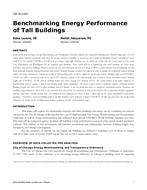Description
Early results from Chicago’s Energy Benchmarking and Transparency Ordinance indicate that commercial buildings over 250,000 square feet (23,225 square meters) perform statistically better than the average commercial buildings as reported by the Commercial Buildings Energy Consumption Survey (CBECS). The median ENERGY STAR score of Chicago’s large office buildings was 78, which was in-line with the results found in New York City, Philadelphia and Washington DC for similarly sized buildings. These results lead us to hypothesize that taller buildings are better energy performers than low-rise buildings. However, because the raw data collected by the City of Chicago in 2014 as part of the first year of compliance was not made publically available, benchmarking data from private Portfolio Manager accounts was collected in order to analyze the relationship between building height and energy consumption. Significance testing of benchmarking data revealed a significant relationship between building height and ENERGY STAR score with a measured p-value of less than 0.05. However, analysis of the benchmarking data revealed no linear correlation between building height and ENERGY STAR score or building height and Source Energy Use Intensity (EUI). The second portion of the paper compares the benchmarking data set against a pool of tall building energy model simulations. The model analysis found a significant negative correlation between Building Height and Source EUI in office buildings located in Illinois. It was also found that there is a significant relationship between Occupancy and building energy performance which leads to the conclusion that other factors not considered as part of this analysis such as operating schedules, equipment efficiency, plug loads, envelope constructions, and building operator proficiency are likely to have a major effect on the energy consumption of operational buildings. Nevertheless, increased building height of an office building can be indicative of higher ENERGY STAR score given that this rating system normalizes for various factors including square footage, occupancy, weather, and equipment usage.
Citation: 2016 Winter Conference, Orlando, FL, Conference Papers
Product Details
- Published:
- 2015
- Number of Pages:
- 8
- Units of Measure:
- Dual
- File Size:
- 1 file , 1.2 MB
- Product Code(s):
- D-OR-16-C007




